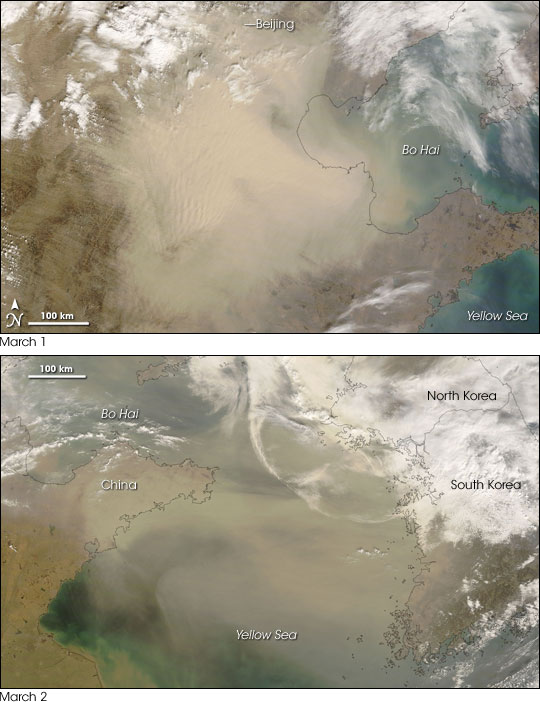


March often brings an increase in dust storms to East Asia, and 2008 proved no exception. In early March 2008, the characteristic “yellow dust” from the Gobi Desert blew eastward over the Beijing region, the Yellow Sea, and North and South Korea. The Moderate Resolution Imaging Spectroradiometer (MODIS) on NASA’s Terra satellite acquired the top image on March 1, 2008, and the bottom image the next day.
The top image shows a cloud of tan-colored dust south of Beijing, just beginning to pass over Bo Hai. The dust is thick enough to completely obscure the land surface below. The ripple pattern near the western edge of the plume results from midair waves of dust. The bottom image shows the dust plume continuing its eastward journey over the Yellow Sea, toward the Korean Peninsula. In this image, the dust plume has thinned somewhat, but remains a coherent mass of dust.
For centuries, China experienced regular dust storms, but the latter half of the twentieth century brought an increase in these storms, likely due to human activities such as overgrazing. From AD 300 to 1949, a dust storm typically struck northwestern China every 31 years. After 1990, the occurrence increased to once a year. As China industrialized, the dust storms began to pose new hazards as the dust plumes picked up toxins on their way to the sea. The dust storm in early March 2008 prompted South Korean officials to advise precautions for children, the elderly, and people with sensitive respiratory systems.
March often brings an increase in dust storms to East Asia, and 2008 proved no exception. In early March 2008, the characteristic “yellow dust” from the Gobi Desert blew eastward over the Beijing region, the Yellow Sea, and North and South Korea. The Moderate Resolution Imaging Spectroradiometer (MODIS) on NASA’s Terra satellite acquired the top image on March 1, 2008, and the bottom image the next day.
The top image shows a cloud of tan-colored dust south of Beijing, just beginning to pass over Bo Hai. The dust is thick enough to completely obscure the land surface below. The ripple pattern near the western edge of the plume results from midair waves of dust. The bottom image shows the dust plume continuing its eastward journey over the Yellow Sea, toward the Korean Peninsula. In this image, the dust plume has thinned somewhat, but remains a coherent mass of dust.
For centuries, China experienced regular dust storms, but the latter half of the twentieth century brought an increase in these storms, likely due to human activities such as overgrazing. From AD 300 to 1949, a dust storm typically struck northwestern China every 31 years. After 1990, the occurrence increased to once a year. As China industrialized, the dust storms began to pose new hazards as the dust plumes picked up toxins on their way to the sea. The dust storm in early March 2008 prompted South Korean officials to advise precautions for children, the elderly, and people with sensitive respiratory systems.
NASA images courtesy Jeff Schmaltz, MODIS Rapid Response team. Caption by Michon Scott.